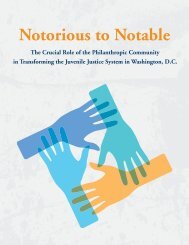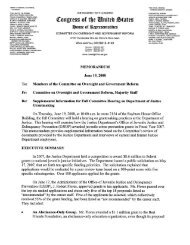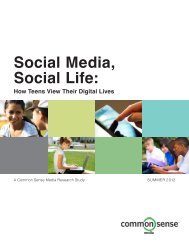Higher Education: Gaps in Access and Persistence Study
Higher Education: Gaps in Access and Persistence Study
Higher Education: Gaps in Access and Persistence Study
You also want an ePaper? Increase the reach of your titles
YUMPU automatically turns print PDFs into web optimized ePapers that Google loves.
Table<br />
28-1. Percentage of high school seniors who took or planned to take college preparatory <strong>and</strong>/or entrance<br />
exam<strong>in</strong>ations, by type of exam<strong>in</strong>ation, sex, <strong>and</strong> race/ethnicity: 2004............................................................143<br />
28-2. Among high school seniors who took or planned to take the SAT or the ACT, percentage who took<br />
or planned to take various steps to prepare for these tests, by type of preparation, sex, <strong>and</strong><br />
race/ethnicity: 2004......................................................................................................................................144<br />
28-3. Among high school seniors who planned to cont<strong>in</strong>ue their education after high school, percentage<br />
who applied to one or more postsecondary <strong>in</strong>stitutions while <strong>in</strong> high school, by sex <strong>and</strong><br />
race/ethnicity: 2004...................................................................................................................................... 145<br />
29-1. Percentage of high school seniors who planned to cont<strong>in</strong>ue their education after high school <strong>and</strong>,<br />
among seniors who planned to cont<strong>in</strong>ue, the percentage who used <strong>in</strong>formational resources on college<br />
entrance requirements, by type of <strong>in</strong>formational resource, sex, <strong>and</strong> race/ethnicity: 2004..............................148<br />
30-1. Percentage of high school seniors with postsecondary aspirations who reported select school choice<br />
factors as very important, by school choice factor, sex, <strong>and</strong> race/ethnicity: 2004........................................... 153<br />
31-1. Among 2004 high school seniors who had applied to college by 2006, percentage who applied for<br />
f<strong>in</strong>ancial aid, <strong>and</strong> among those who did not apply, percentage who reported various reasons for not<br />
do<strong>in</strong>g so, by sex <strong>and</strong> race/ethnicity: 2006...................................................................................................... 156<br />
32-1. Among high school seniors with postsecondary aspirations, the percentage who reported participat<strong>in</strong>g<br />
<strong>in</strong> college preparatory <strong>and</strong> awareness programs, by race/ethnicity <strong>and</strong> sex: 2004........................................... 159<br />
Page<br />
33-1. Number <strong>and</strong> percentage of 18- to 24-year-olds <strong>in</strong> the household <strong>and</strong> group quarters population, by<br />
school enrollment status, sex, race/ethnicity, <strong>and</strong> nativity: 2010....................................................................166<br />
33-2. Number <strong>and</strong> percentage of 18- to 24-year-olds <strong>in</strong> the household <strong>and</strong> group quarters population, by<br />
school enrollment status, sex, race/ethnicity, <strong>and</strong> nativity: 2006...................................................................168<br />
Chapter 6—Postsecondary <strong>Education</strong><br />
34-1. Percentage of academic year 2004 high school graduates, by the tim<strong>in</strong>g of first postsecondary<br />
enrollment, sex, <strong>and</strong> race/ethnicity: 2006..................................................................................................... 173<br />
Contents<br />
34-2. Percentage of academic year 2004 high school graduates, by the level of postsecondary <strong>in</strong>stitution first<br />
attended, sex, <strong>and</strong> race/ethnicity: 2006......................................................................................................... 174<br />
34-3. Percentage of academic year 2004 high school graduates, by the selectivity of the first postsecondary<br />
<strong>in</strong>stitution attended, sex, <strong>and</strong> race/ethnicity: 2006........................................................................................ 175<br />
35-1. Average annual tuition <strong>and</strong> fees, price of attendance, <strong>and</strong> f<strong>in</strong>ancial aid for undergraduates who<br />
attended full time, full year at one <strong>in</strong>stitution, by sex <strong>and</strong> race/ethnicity: Academic year 2007–08............... 179<br />
36-1. Percentage distribution of undergraduate postsecondary students, by enrollment <strong>in</strong>tensity, sex, <strong>and</strong><br />
race/ethnicity: Academic years 2003–04 <strong>and</strong> 2007–08.................................................................................182<br />
37-1. Percentage distribution of persistence <strong>and</strong> atta<strong>in</strong>ment by June 2009 of 2003–04 beg<strong>in</strong>n<strong>in</strong>g<br />
postsecondary students by highest degree atta<strong>in</strong>ed, sex, <strong>and</strong> race/ethnicity: 2009.........................................186<br />
37-2. Percentage of 2003–04 full-time, beg<strong>in</strong>n<strong>in</strong>g postsecondary students who first attended a 4-year<br />
<strong>in</strong>stitution <strong>and</strong> percentage distribution of their persistence <strong>and</strong> atta<strong>in</strong>ment status by June 2009,<br />
by sex <strong>and</strong> race/ethnicity: 2009.....................................................................................................................187<br />
38-1. Percentage of 2003–04 beg<strong>in</strong>n<strong>in</strong>g postsecondary students who left school by 2004 without complet<strong>in</strong>g<br />
a program <strong>and</strong> the reported reasons for leav<strong>in</strong>g, by sex <strong>and</strong> race/ethnicity: 2004..........................................190<br />
39-1. Percentage of first-year undergraduates who reported ever tak<strong>in</strong>g a remedial course, by level of<br />
<strong>in</strong>stitution, sex, <strong>and</strong> race/ethnicity: Academic years 2003–04 <strong>and</strong> 2007–08.................................................194<br />
List of Tables<br />
xxvii












